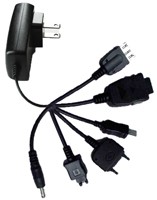I have known for some time that the European Union intends to introduce a new standard for charging mobile terminals in the form of a micro-USB port. More than a year has passed since the European agencies CEN-CENELEC si ETSI is working on the development of a methodology for the implementation of this standard, so yesterday it was finally done published. EU officials say that starting with the first months of 2011 we will see the first terminals manufactured according to this new standard.
Apple has signed the agreement regarding the implementation of this new standard in its terminals and it is possible that the first iDevice with a micro-USB port will be the iPad 2. If it is not the case, then the future model of the iPhone terminal will certainly have such a port because Apple has already accepted the conditions imposed by the European Union and will certainly respect them.
Commission welcomes new EU standards for common mobile phone chargers
Following a mandate from the European Commission, the European Standardization Bodies CEN-CENELEC and ETSI have now made available the harmonized standards needed for the manufacture of data-enabled mobile phones compatible with a new common charger. This is the most recent development in the process towards a global common mobile phone charger initiated by the European Commission. It follows the June 2009 agreement of fourteen leading mobile phone producers to harmonize chargers for data-enabled mobile phones (ie that can be connected to a computer) sold in the European Union.
European Commission Vice-President Antonio Tajani, Commissioner for Industry and Entrepreneurship, said: "I am very happy that the European Standardization Bodies have met our request to develop within a short space of time the technical standards necessary for a common mobile phone charger based on the work done by industry. Now it is time for industry to show its commitment to sell mobile phones for the new charger. The common charger will make life easier for consumers, reduce waste and benefit businesses. It is a true win-win situation."
Incompatibility of chargers for mobile phones is not only a major inconvenience for users, but also a considerable environmental problem. Users who want to change their mobile phones must usually acquire a new charger and dispose of the old one, even if it is in good condition. In response to citizens' demand for a common charger, the Commission invited manufacturers to agree on a technical solution making the chargers of different brands compatible.
As a result, world leading mobile phone producers committed themselves to ensure the compatibility of data-enabled mobile phones, expected to be predominant in the market within two years, on the basis of the Micro-USB connector. The agreement was established in June 2009 and signed by Apple, Emblaze Mobile, Huawei Technologies, LGE, Motorola Mobility, NEC, Nokia, Qualcomm, Research In Motion (RIM), Samsung, Sony Ericsson, TCT Mobile (ALCATEL), Texas Instruments and Atmel (IP/09/1049).
The Commission then issued a mandate to the European Standardization Organizations CEN-CENELEC and ETSI in December 2009, requesting the development of European standards for the common charger. The two organizations have now delivered. The standards allow for interoperability, ie the common charger is compatible with data-enabled mobile telephones of different brands. They also take into account safety risks and electro-magnetic emissions and ensure that common chargers have sufficient immunity to external interference.
The European Commission expects the first common chargers and mobile phones compatible with the new standards to reach the European market in the first months of 2011.

















